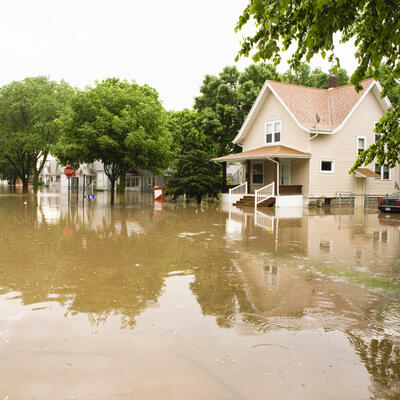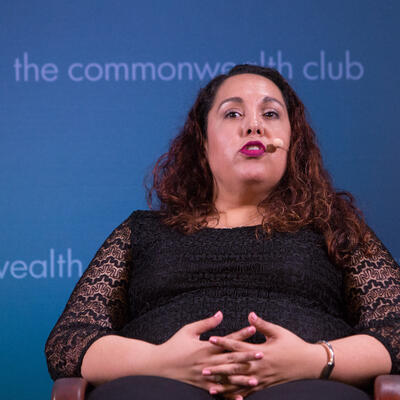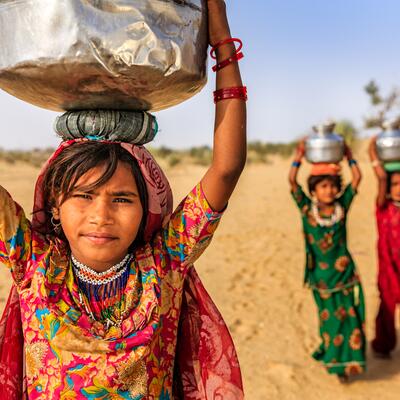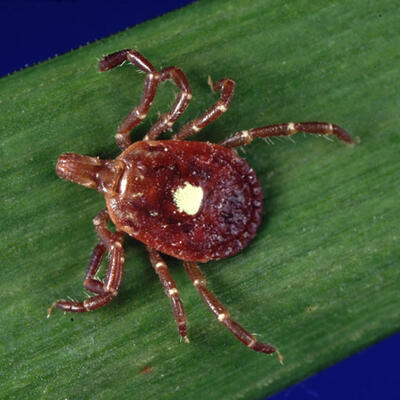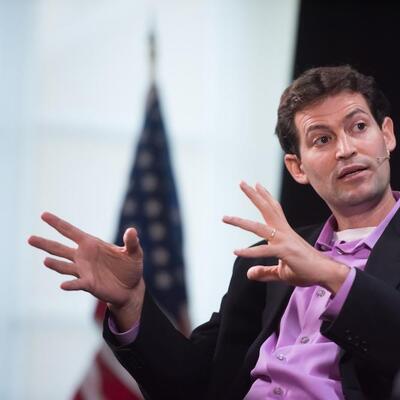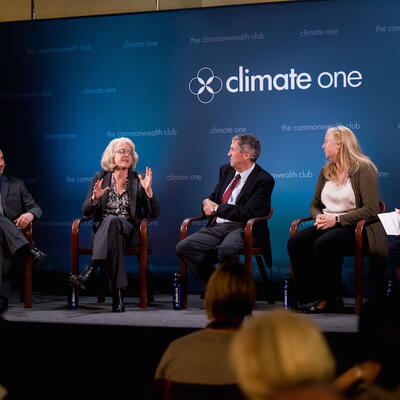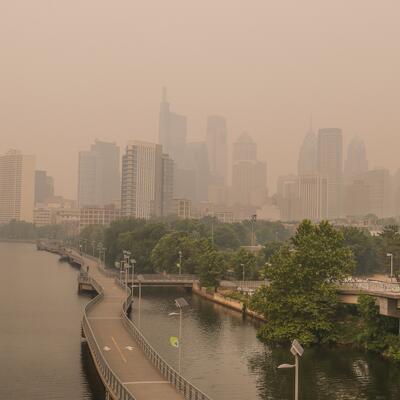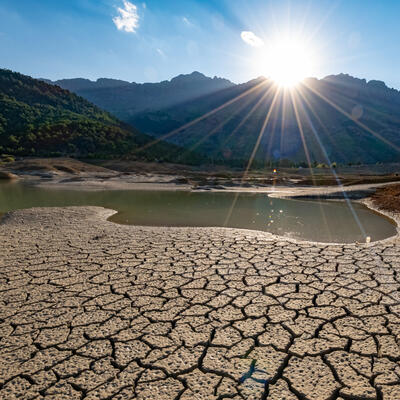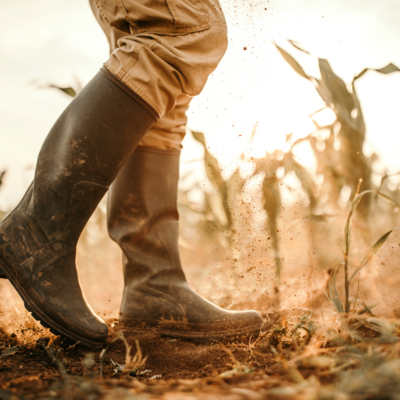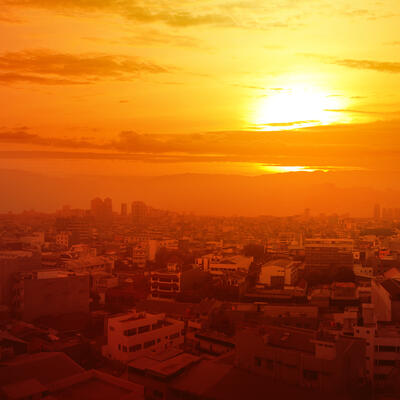
Extreme Heat: The Silent Killer
Guests
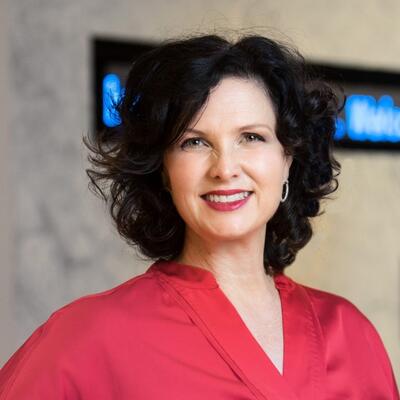
Kathy Baughman-McLeod

Cheryl Holder

Dennis Todey
Summary
Last week’s heat wave across the western United States busted more records – a trend that doesn’t seem to be going away.
Despite the serious threats extreme heat presents to our health, livelihoods and economy, we tend to perceive intense heat events differently from other climate disasters, says Kathy Baughman-McLeod, senior vice president and director of the Adrienne Arsht-Rockefeller Foundation Resilience Center.
“[Heat events] don’t have the drama that a flood or hurricane has. It just doesn’t have the visual nature,” she says.
In 2020, the center created the Extreme Heat Resilience Alliance, which aims to build a network of city leaders and experts to tackle the growing threat of extreme urban heat around the world.
“One of the misconceptions is that it's the hot places, but really it's the places least accustomed to heat who are least prepared to withstand it,” Baughman-McLeod says. We don’t track heat-related deaths very well, nor the other associated impacts of heat, like the economic cost of a heat wave, she says.
Because heat disproportionately impacts low-income communities and communities of color, “a chief heat officer wakes up every day thinking about how to protect people and their livelihoods, especially vulnerable people,” Baughman-McLeod says. “We need to be heat risk informed: what are the risks, who is most at risk, where are they, what are the interventions that can help protect them, how much they cost, how do we pay for it, how do we coordinate and learn from other cities that are doing this?”
Miami-Dade County is one of the places that has joined the alliance. Physician Cheryl Holder is co-chair of Miami-Dade’s new Heat-Health Task Force and has spent decades working with populations more at risk for heat impacts.
“The people who are doing the work outdoors, the people who work at the service level, the people who you hear about the coronavirus who are now called the ‘frontline workers,’ that's always been my people that I’ve cared for,” Holder says.
Holder says she uses a mnemonic with her patients to understand the myriad effects of heat.
“It’s called HEAT WAVE and each of those letters stand for the main areas that this climate is impacting us,” she says, from heat illness to worsening allergies to waterborne and vector-borne disease and the exacerbation of mental health complaints.
Holder says she’s working to convince her peers, particularly older doctors, about the risk of extreme heat and climate change on their patients and practices. She also advocates for better heat warning systems and equity-driven education outreach measures.
Meanwhile, farmers in the nation’s heartland are trying to figure out what their future holds. Dennis Todey is director of the USDA Midwest Climate Hub. He says the region is experiencing more heat, especially in the form of higher overnight temperatures and higher humidity.
“That humidity actually is helpful for crops,” like corn and soybeans, he says. “But that humidity issue for humans and livestock or animals is a whole other set of problems.”
Todey says farmers are aware of the changing conditions and working to figure out how to respond to them.
“We know that there are natural variabilities and varies from year to year. So, agriculture does try to deal with those. The problem we’re having now is some of those variations and some of those changes are becoming larger and harder to deal with."
Related Links:
Extreme Heat Resilience Alliance
Midwest Climate Hub
Miami-Dade Chief Heat Officer
Climate Change and Extreme Hea
Full Transcript
Greg Dalton: This is Climate One. I’m Greg Dalton. It’s the middle of summer… and it’s hot. Really hot. Last week’s heat wave across the western states busted more records--a trend that doesn’t seem to be going away. Some places are used to triple-digits, but in other places, lower temperatures can be deadly. Despite the serious threats extreme heat presents to our health and economy, we tend to perceive intense heat differently than other climate disasters.
Kathy Baughman-McLeod: They don’t have the drama that a flood or hurricane has. It just doesn’t have the visual nature.
Greg Dalton: A Miami doctor says heat impacts can be cumulative and slow-moving:
Cheryl Holder: So it’s not simply that you’re going to get a heat stroke and pass out. That’s the worst portion of heat. But it’s the earlier insults that many of our physicians are missing.
Greg Dalton: Meanwhile, farmers in the nation’s heartland are trying to figure out what their future holds.
Dennis Todey: Agriculture is not going to go away in these regions because there are good soils and they’re highly productive lands but it probably becomes we grow something else. And what that else is we don't know at this point.
Greg Dalton: Climate One’s empowering conversations connect all aspects of the climate emergency. Today, we explore the impacts of extreme heat. What does extreme heat mean for human health, our cities and our farms? Climate One’s empowering conversations connect all aspects of the climate emergency. I’m Greg Dalton.
Greg Dalton: Kathy Baughman-McLeod is Director of the Atlantic Council's Adrienne Arsht-Rockefeller Foundation Resilience Center. Last year the center created the Extreme Heat Resilience Alliance, which aims to build a network of city leaders and experts to tackle the growing threat of extreme urban heat around the world. Between 2000 and 2009, heat killed more Americans than hurricanes, but we hear a lot more about hurricanes and other dramatic climate events. Kathy Baughman-McLeod says there are several reasons for that.
Kathy Baughman-McLeod: And I think the top of the list is the fact that they are quiet they don't have the drama that a flood or hurricane has just doesn't have the visual nature. And if you think about something that rips the roof off of the house imagine the weather channel and how they're able to cover those storms and the meteorologist stand in the wind in the action and their hair is blowing sideways and it is dramatic. And if you do an aerial photograph of a place that's had a deadly heat wave from one day to the next there's not a difference. And so, it's hard to compete with that drama in terms of the visual understanding of what damages it's you know it's wreaking over a community.
Greg Dalton: Yeah, quiet, slow, kind of less visible. How are the heat impacts distributed across regions across the demographics within a region? I looked at the CDC map of regions affected by unusual heat events and it looked pretty dark red across the country except for a little piece up in Alaska.
Kathy Baughman-McLeod: Yeah, it's really far-reaching and one of the misconceptions is that it's the hot places but really it's the place least accustomed to heat who are least prepared to withstand it. And the number of days at a certain temperature threshold just continues to grow and you can look at Miami and say the number of days at what feels like 105°F is growing from I think it's 17 days to 45 days. In the climate scenarios you see those days rising to where a third of the year people are experiencing 105°. But if you live in Minnesota you are not accustomed anywhere near 105° and so a lot of heat planning and addressing extreme heat it’s about the human body. Your underlying conditions, your age, the elevation, the humidity, pollution, all sorts of things factor into the way humans experience heat.
Greg Dalton: And recent update from the U.S. EPA shows that heat waves in major cities occurred three times as often in the 2010s as they did in the 1960s and heat waves are becoming more frequent. So, it seems like anyone over 30 would be experiencing and feeling this personally. So, why does heat still not get the attention it deserves?
Kathy Baughman-McLeod: I think in part it is about the slow creep of the increase in temperature. It is dramatic, it is disrupting us now, but the biggest if you look at the deaths, a lot of times elderly people who die alone who are alone in their apartments who they may be un-air-conditioned or they may feel like they can’t afford to run the air-conditioning. We don't record heat death the way we do other things. And so, there's not a box to check. If you take yourself to the hospital, they might say oh your heat has exacerbated your condition, but the box to check is renal failure, kidney failure, heart failure. And so, we don't really know and I think one of the biggest challenges is the data.
Greg Dalton: So, you said that heat is the biggest threat that climate crisis offers and we don't have a handle on it. If the data is so clear and it happens, why don’t we have a handle on it?
Kathy Baughman-McLeod: Well, the data is clear that it's getting hotter. And the way our cities are built is not helping. So, we have the urban heat island effect we have asphalt that absorbs heat and then it emanates at night. We have the they call it the diurnal range you know the range of temperature from the daytime to the nighttime it’s shrinking. The human body rests, and cleanses the brain at night and when you have temperature still high at night we don't rest and we wake up tired and we make mistakes and hurt ourselves at work and things like that. I think we also don't have a handle on it because there is still this lack of data that I referenced just a minute ago of really understanding yes, it's hot, but then how does it play out. We've read a few stories about how the airplanes in Phoenix can't fly when it's a certain high temp and how many days do we expect that that will happen and what is that economic impact that it has. We don't really have those numbers either. So, how much is the cost to have a heat wave or to prepare for one or to respond to one. Those are all things that we need suss out.
Greg Dalton: And some cities are more prepared, you expect Houston and Miami to be really hot and you said the people there, kind of accustomed to it. What about cities that you mentioned Minnesota, that are less accustomed to heat waves and the population is less accustomed to living through them and knowing what to do and how to hydrate and when to go to a cooling center or what to do outside or not do outside.
Kathy Baughman-McLeod: You’re exactly right. And those populations, they need that education and they need to build that culture of preparation that we've built for hurricanes and fires. We think that naming and ranking heat waves is a good way to do that to trigger those behaviors and to bring in all of those interventions. When the UK last summer lost 2500 people to heat, they put out a new heat health warning system and it failed because it came out too late. And so, for certain people with certain medical conditions 16 hours or 10 hours makes all the difference. And if the warning doesn't come out in time, people die. And so, knowing that and knowing what to do and having the public officials and health department all working together to share those messages is essential.
Greg Dalton: So, what is the chief heat officer program and what do you hope with city's chief heat officer will actually be able to do?
Kathy Baughman-McLeod: A CHO, chief heat officer, wakes up every day thinking about how to protect people and their livelihoods, especially vulnerable people. And I think one thing we need to say right at the top is that heat does not affect people and communities equally and it is preying upon low-income communities and communities of color all across the world and especially in the US. And so, if you look at a map of tree cover which is one of the best ways to cool community looking at a map of tree covers like looking at a map of race in American cities.
Greg Dalton: And redlining, yeah.
Kathy Baughman-McLeod: And redlining and racist housing practices all show up in the tree cover and the leafy cool neighborhoods versus the neighborhoods that are mostly concrete without tree covering green space the temperature difference can be as much a 17° in the same city and there's a big equity issue here. But the chief heat officer will focus on those communities, but also work that’s going on already can be coordinated, new work to address heat and understand the heat risks and a lot of times this is just about not understanding what the risks are. So, we need to be heat risk informed: what are the risks, who is most at risk, where are they, what are the interventions that can help protect them, how much they cost, how do we pay for it, how do we coordinate and learn from other cities that are doing this. All of that would fall within the remit of a chief heat officer.
Greg Dalton: My guest today is Kathy Baughman-McLeod, Director of the Atlantic Council's Adrienne Arsht-Rockefeller Foundation Resilience Center. The Rockefeller Foundation previously created a program of chief resilience officers I think there was 100 cities around the world. The idea to create these positions the first time in city government and those were actual new positions within city government. And the chief heat offices are not positions funded by this new program. And I remember one of the problems of the chief resilience officers was they didn't have a budget they didn't have a bureaucratic army. There were, this one person in this government bureaucracy and it’s hard to move if you don't have that kind of muscle behind you. So, how can you expect cash-strapped cities to add more responsibility to existing staff without increased funding. What can these heat officers really get done other than kind of, I don’t know, issue press releases?
Kathy Baughman-McLeod: That's a good question. So, the first thing is to acknowledge right from the front they are cash-strapped. These cities are facing so many pressures and the economic impacts of COVID at the top of the list, but also responding to climate crises and all sorts of things, and local government’s mayors are at the tip of the spear for handling all these things that are impacting people's lives. So, our approach is to first of all acknowledge that and say where can you find the capacity that you have that can aggregate your efforts around heat. So, this person sits right next to the mayor and that's the difference between somebody that is trying to coordinate that doesn't have the power of the mayor behind them and not to say that CROs didn't because many of them sat right next to their mayors and were empowered to act. But in the partnership that we have part of our role as the Extreme Heat Resilience Alliance and we have an initiative specifically for mayors called the city champions for heat action. Specifically, we are raising money to invest in the CHOs and the work that these cities are doing. And the best approaches are coming out of the Extreme Heat Resilience Alliance with this group from around the world. And so, we expect that the mayor supports the CHO and the mayor is also actively involved and that's the deal for us is that you have that power.
Greg Dalton: And how do you decide which cities to support?
Kathy Baughman-McLeod: Well, we’re looking for places where we can be successful. So, you know, we always talk about the enabling conditions. So, where is there a climate leading mayor to start. A mayor that is already talking about climate change, acting on climate change and is facing heat risk and needs help, but is ready to spend time and effort on it. That's the first. Also, where is the heat risk and where are people most vulnerable.
Greg Dalton: I read an article once in the New York Times titled How Air-Conditioning Conquered America. It’s something we take for granted but the south would be, you know, unlivable in many ways and that really after World War II there's this big expansion of air-conditioning. It noted that now central air-conditioning is rising in new homes constructed in the West it’s already pretty much everywhere in the south but is rising in the West in places like the Bay Area where we never used to have air-conditioning before. So, as it gets hotter what are the impacts of people getting air-conditioning using it more on our national emissions of carbon pollution?
Kathy Baughman-McLeod: This is a serious concern and those are real numbers. Those numbers going up and then the key thing is, what's the source of the power that is creating the air-conditioning. And so, is it fossil fuels, and if it is, we’re increasing our emissions, period. Part of the approach of the Extreme Heat Resilience Alliance and some of our interventions, you know, there’s nature-based solutions like tree cover. They reduce your power bill. They reduce your need for air-conditioning. So, there are these passive solutions that we are promoting. And then there are the energy-based solutions. And so, that means we got to push to shift to as much renewable energy as we can to be the source of that power, but I think we also we’re facing a bigger conversation about where can people continue to live. There was an incredible work done by Abrahm Lustgarten with ProPublica and the New York Times several months back about how much of the world will be uninhabitable because of the temperatures. And we’ll be going from 2%, which is currently uninhabitable to 19% uninhabitable. So, a fifth of the world is uninhabitable. What does that mean and how do you move people and do food systems collapse or economies collapse before we move. And so, we’re not taking that on right now we're trying to protect vulnerable people. That's a, you know, that's what's in front of us right now, but those are big questions we’re gonna have to answer.
Greg Dalton: You mention the economic impact of heat. Is that economic impact of heat being recognized by governments, companies and citizens?
Kathy Baughman-McLeod: No, no, and there's another great paper that's coming out in July about workers comp data and the economic impact. So, similar economic impact of the health, the morbidity and mortality outcomes from workers who are hot and that’s both people working outside and in warehouses where they’re un-air-conditioned. So, we don't have a national heat protection standard for workers in the US and that’s something we'd like to see put in place. And so, you think about Phoenix as I was saying and the airport being shut down, you know, what are the reverberations of the airport being shut down. And you can calculate how many more days given the climate scenarios where the airplanes just can't fly. Does that mean fewer businesses come to Phoenix because there's instability in the transportation of goods and people? So, those are big questions.
Greg Dalton: How can finance and insurance be used to reduce climate and heat risk?
Kathy Baughman-McLeod: When we think about access to capital for cities how do we create affordable access, easy access and project preparation facilities and get finance moving quickly in the cities to invest in these things like changing over your pavements so that they are reflective or investing in urban forest. But then on the risk side you want to have some money before the heatwave comes just like you'd like to have money before the hurricane comes so you can get ready. And so, we're looking at risk transfer products, you know, there’s a certain type of product called the parametric insurance policy. It pays on a trigger, an event, not the damage which is the way indemnity insurance works, which is what we have in our homes. So, you have damage they assess the damage and then you have a payout. This happens when a certain thing happens. So, if the heat index is 104° for three days, money drops into the treasury of the city. But what we want to do is have the money drop on the forecast. And so, we are building forecast-based insurance and so the trigger is the forecast, the money drops, in you have generators, you have cooling centers, you have people going door-to-door to make sure folks are safe or can go someplace safe. And so, we're experimenting with all of the risk and finance tools and approaches that can help bring more protection and reduce the cost and suffering.
Greg Dalton: That’s interesting because insurance of course, is probabilistic. It's all based on math and probability and we know it’s gonna get hotter and so get the money before it happens when cities need it rather than having to wait afterwards.
Kathy Baughman-McLeod: Well, there's a great example that inspired us and that is a program called the Kenyan livestock insurance program and in short, farmers were having their cattle die and their insurance would pay out when you sent photos of the dead cattle and then money would come to the cell phone of the farmer and they would replace their cattle. And so, Swiss Re and the Kenyan government and others got together and said this doesn't make any sense there must be some way to get in front of their deaths. And so, they use remote sensing to estimate the vegetation's hydration level and when it drops to a certain point that’s dangerous for the cattle, it brings cash to the farmer to their phone beforehand and then they are able to buy water and buy what they need to keep the cattle alive. And so, the idea of moving forward in the chain of the instrument is what we're trying to do for heat.
Greg Dalton: Well, we do have some things to learn from the rest of the world. Kathy Baughman-McLeod. Thanks for coming on Climate One, I appreciate your insights today.
Kathy Baughman-McLeod: Thank you, Greg.
Greg Dalton: You’re listening to a Climate One conversation about the impacts of extreme heat. If you missed a previous episode, or want to hear more of Climate One’s empowering conversations, subscribe to our podcast wherever you get your pods. Coming up, a Miami doctor shares some of what she’s seeing in her exam room:
Cheryl Holder: I use a mnemonic with my patients and all the docs I see. And it’s called HEATWAVE. And each of those letters stand for the main areas that this climate is impacting us.
Greg Dalton: That’s up next, when Climate One continues.
Greg Dalton: This is Climate One. I’m Greg Dalton, and we’re talking about the numerous impacts of extreme heat, which is becoming more prevalent in our disrupted climate.
Dr. Cheryl Holder is very familiar with the direct and indirect impacts of heat on human health. She’s worked in Miami for 30 years, starting with the National Service Corps Payback program.
Cheryl Holder: And I was assigned to Miami working in Overtown, Little Haiti, Little Havana these are all small poor communities in Miami and eventually I worked in Opa-locka Miami Gardens, another poor black community for 20 years. Now my practice for the last 10 years has been back at the main hospital in the outpatient division and we are the only safety net hospital in the county. So, we take uninsured undocumented. So, that's my population. So, it's the people who are doing the work outdoors, the people who work at the service level, the people who you hear about the coronavirus who are now called the frontline workers. That's always been my people that I’ve cared for and I tried to serve as best as possible.
Greg Dalton: I’ve talked to various doctors over the years about climate change and they often don't see it, you know, related to their practice. They say it is something kind of far away. What are the human health impacts of extreme heat?
Cheryl Holder: Well, heat alone that’s just one aspect of the climate, the direct impact of climate change. But since you heard my population, I see people who come in because of the heat, the complaints. I just had a patient recently she works 12 hours in a very, very hot nursery. And her diabetes was uncontrolled and I kept increasing the medicines. I said you gotta get some breaks, you got to drink more fluids. And I follow her numbers and it just could not get it under control. I saw her recently. The numbers were almost, almost where I want them. I said, what happened, you're taking all your medicines? She says I quit the job. She realized that because we've been working it was just too hot. My other patients that I see come in where they feel dizzy and then they come in with a sprained ankle. They were hot, they're a little dizzy, they trip. But I was treating this for years. It wasn't like 2016 when my one patient came in and couldn't pay her light bill because she was running up the AC because it was so hot and her COPD was decompensating. And it all came together in 2016 because then all the headlines this is the hottest year hottest year and I’m like, oh my god. And so, once you become more aware you start expanding the differential we say in medicine, starting using more reasoning of their other reasons why this patient’s COPD is worse, why their sugars can’t come under control. It can all be that everybody's eating and cheating when especially I have patients who I know are adherent because I followed them for years. And my women weren't sleeping at night because it's so hot at night and they can’t afford to run ACs all night and they’re like it just doesn't get cool like it used to. And I can't really open up my windows as much because they don't live in the safest neighborhoods, then the screens aren't there because their landlords don't put screens and then you have mosquitoes. So, the constant areas that climate can impact us is that affecting this population. I use a mnemonic with my patients and with all the docs I see. And it’s called HEAT WAVE and each of those letters stand for the main areas that this climate is impacting us. And you mentioned heat, H. That is one of the biggest things that we experience in South Florida. So, it's not simply that you gonna get a heat stroke and passing out. That's the worst portion of heat, but it's the earlier insults that many of our physicians are missing.
Greg Dalton: What are the eight -- spell out heat what it stands for.
Cheryl Holder: Okay. H, for heat illness. E, exacerbation of heart and lung disease. A, worsening asthma. T, Traumatic events which comes during these extreme weather events. W, waterborne illnesses. A, the allergies worsening allergies. V, vector borne diseases. Then the last E is exacerbation of mental complaints, just worsening of mental health.
Greg Dalton: Right. So, we think about heat as direct, but it sounds like it's also very indirect. Someone who's tripping on a hot day or can't sleep at night that heat is sort of not recognized as a climate related health impact. I’m wondering if your patients make the climate connection when they come to you about these underlying affecting their sleep or their other aspects of their health you just outlined.
Cheryl Holder: No, not at all. And not in the beginning I do see more now that we're talking about climate and health more. But in general, no, in general I have to help them recognize it. It's like my patient who I told you earlier who I wanted her to keep working because she needs to work to pay all her bills but she accepted that she just couldn't tolerate the heat. And we started educating her more on ways that she could survive while she was working, taking more breaks. And that's when she started to click that it is much hotter now than even last year when she worked at the same job. So, that's when we started introducing the topic that yeah, the climate is changing.
Greg Dalton: How about your peers, your medical peers and colleagues are they seeing climate as a health concern much the way that we’ve talked about framing gun violence as a health concern. Are your peers in the medical field seeing climate as a health concern?
Cheryl Holder: The older docs not so much but I must say the younger docs that are coming out the medical students and the young docs are. And they are our biggest voice right now in pushing the curriculum, pushing the health systems to acknowledge it and then pushing for decarbonizing the health systems. So yes, there is a groundswell that is coming from the younger docs. Much of the older docs, what I’ve really tried to show them is that as these extreme weather events happen, how is your practice going to survive these extreme weather events? Because here we’re in Florida and if our hurricanes get more intense, even if they don't get more frequent that basically takes you out of practice for a while. And if your insurance rates go up so your day-to-day practice of medicine is going to be impacted. So, I am working with them on the economic side and then as they look at it, I said, think about what's happening with you. Think about your patients. The doctors who work with poorer patients are much more aware of it. The National Medical Association did a survey of its physicians and the National Medical Association physicians are African-American physicians and we serve primarily an African-American community and poorer patients. And a majority of those doctors identify climate as one of the big issues, but a lot of the African-American doctors are in the South and we have always been part of the environmental justice movement for very long because we were caring for the patients who live along the Mississippi who were exposed to all the environmental dangers. We work with patients who are in redlined areas and were presenting with the children with more asthma and the more decompensated COPD. So, we’re much more aware of it because of the population that we serve.
Greg Dalton: Yet another example of how people of color are closer to climate impacts and more on board with recognizing the risks. Dr. Cheryl Holder is a physician on the faculty of Florida International University's Herbert Wertheim College of Medicine, and cochair of Miami-Dade's new Heat Health Task Force. Dr. Holder, you've talked about climate gentrification. What do you mean by that and I think that’s happening in Miami and other coastal areas and how is that also health impact?
Cheryl Holder: Yeah, climate gentrification is the term that climate advocates have noticed that where the richer people if they're more impacted by the climate change and in our communities anything along the coast, sea level rise is causing more degradation of the coastline, the waters are rising. So, the population is going to start moving to areas that are safer. In Miami and South Florida, the safer regions are on the higher ground along our ridge. The railroad tracks were put in some of the highest areas so that might be 13 to 15 feet above sea level. You remember Miami was developed post-civil war, Jim Crow era, total segregation, poor people, Black people were left at the worst spots in the land which is by the railroad tracks. These railroad tracks are on high ground. So, when a population that cared for Liberty City, Little Haiti that have endured hurricanes and never flooded because they're higher are now unable to pay their rents. Their property values are going they can’t pay their property taxes. They’re being lured to sell if they do own and many don't own but a few that own are also lured out of these neighborhoods. But the worst part really is that as the value goes up, they can’t afford to rent and their landlords are evicting them and moving them out. So, we're having climate gentrification on land that was undesirable at the beginning but the rich folks can afford to move in. And my population is now moving unfortunately to the low-lying areas because that's now the cheaper places. And so, where I really worry about a hurricane and major flooding that this population that had been protected for so many years are now in the low-lying and I dread a Katrina happening because we do not have the road infrastructure and the public transportation infrastructure to be able to evacuate them from low-lying regions.
Greg Dalton: And a lot of those populations originally came from the Caribbean. You talked in your TED talk about emigrating from Jamaica. I’m curious on a personal level, how you came to view the climate emergencies as a health emergency?
Cheryl Holder: You know, I guess because I tell everybody hashtag not my first pandemic. I was around with HIV-AIDS in the 80s. We just had 40 years. And at that time, it was similar issues the same poor population marginalized population because many of the gay people who were infected were and may not be poor but they were the same marginalized group that we’re not recognized early enough until it became a crisis. And so, as I saw more and more my patients it became evident that this seems just the same thing that we’re experiencing what I experienced back in the 80s with HIV that these folks are going to feel the brunt of it. It's happening now. Just like when we saw my HIV patients. It was something that was happening now and we had to move the governments we have to move everyone to recognize it. And I was back then and I was a young doc with ACT UP and all the groups like we had to scream for people to say people are dying now we have to do something.
Greg Dalton: Right. And as we saw recently with the 40th anniversary of the emergence of the AIDS crisis. AIDS got to a pretty good place with a lot of pain and a lot of death but now people are living with AIDS the drugs are down to one pill per day. It's contained in most places where humanity slowly responded. How do you compare that to the climate response?
Cheryl Holder: Well, as we talk about, I said saw so much improvement but think about the time, we’re talking about 40 years. We don't have 40 years with climate. So, in the model that the HIV world showed us that we can mobilize our forces we can get political will, we can get the dollars if we combine the nonprofit organizations and nongovernmental organizations the private world and the government world. We can get them all together and we can make major changes about a disease like HIV-AIDS and it was worldwide. There was a commitment also for poor people. That took 40 years. If we use the same pace for climate change, we’re not going to do very well and the population that's most vulnerable is going to have a higher death levels than we saw with coronavirus because that is the same population worldwide.
Greg Dalton: As cochair of Miami-Dade's new Heat Health Task Force, what are your main recommendations for what regional government should do to address heat and other impacts of climate disruption?
Cheryl Holder: Well, we talk about already that the population isn't quite aware of the dangers of heat. So, I think we do have a responsibility to educate. Our current system of warning is when it's very high and we know that is just too late. So, we need to change how we warn the population about heat and then when they're warned where do they go for help. And so, the government also I see have to lead in identifying the inequities in the response because if we do not use equity, we will leave a population that's very vulnerable, which will then stress the remaining people. And so, hopefully we can do it in a strategic way that involves public, private, NGOs, everything. It cannot be one, the government answer only. So, this heat health task force is about bringing everybody included at the table from the beginning.
Greg Dalton: So, as we wrap up here, I’m curious as you're taking care of vulnerable people affected in all sorts of visible and invisible and direct and indirect ways by heat driven by the burning of fossil fuels. What do you do yourself to take care of yourself and stay healthy in the growing heat of Miami?
Cheryl Holder: Well, the beautiful thing about climate solutions and anything we do to make the climate better is a health solution. So, I tell my folks I eat even more vegetables than I ever thought possible. Because if you eat less red meat, you're already improving our climate. If I find a safe way of doing physical activity and I do it in the evening or in the day or trying to incorporate more physical activity less car. I'm already improving the climate. Most of all, I tell my patients stop buying stuff. If you can do one thing for the climate and save some money is stop buying things you don't need because you end up using too much packaging, you end up with a lot of junk in your house that you don't meet. But I also tell them don't think that's going to save us. The individual things is the beginning but we really have to push our country, push our policymakers to make the big steps because it's the big things that we do like really cutting down on fossil fuel, really finding ways to price it that we can get the benefits now and help out the poor communities, those are the thing that's going to save us in 10 years.
Greg Dalton: Yeah, well, that’s what we talk about here in Climate One is connecting the individual action with the systemic and connecting the personal and the systemic. Dr. Cheryl Holder, thanks for coming on Climate One today appreciate your insights about heat as a silent climate threat. Thank you.
Cheryl Holder: Thank you very much. It’s a pleasure.
Greg Dalton: You're listening to a conversation about the impacts of extreme heat. This is Climate One. Coming up, how are farmers and ranchers dealing with more hot days and nights?
Dennis Todey: We know that there are natural variabilities and varies from year to year. So, agriculture does try to deal with those. The problem we’re having now is some of those variations and some of those larger changes are becoming larger and harder to deal with. (:14)
Greg Dalton: That’s up next, when Climate One continues.
Greg Dalton: This is Climate One. I’m Greg Dalton. Extreme heat can have big effects on crops and livestock, and the people who produce our food. Climate One Producer Ariana Brocious spoke with Dennis Todey [toddy], director of the USDA’s Midwest Climate Hub in Iowa, about the climate changes affecting farming and ranching in the heart of the country.
Ariana Brocious: So, Dennis most of the attention on the effects of extreme heat tends to focus on people in cities. But how does heat, especially extreme heat, affect crops?
Dennis Todey: You somewhat can't separate crops from drought because extreme heat is problematic for a large number of crops. But if crops can handle some extreme heat if they have enough water available. If they don't have enough water available then even moderate heat can start stressing crops. And then it becomes another issue is to what different types of crops are you talking about and what is extreme for those crops. Like crops that are developed for the Southern Plains or the Southwest they can handle higher temperatures. But when you have some different types of food crops or specialty crops that grow in the upper Midwest or maybe around the Great Lakes area extreme heat, you know, 90s can be difficult or problematic for them based on when they grow and the kinds of conditions of those times of year.
Ariana Brocious: What about humidity. How does that factor in with heat?
Dennis Todey: That is another part of what we’re seeing more in the upper Midwest is that we're seeing not as high of temperatures high daytime temperatures as maybe we did during the 30s and 50s. But we’re seeing warmer overnight temperatures and that's because we’re more humid. The overall humidity is increased. So, even though the daytime temperatures might not be as high. The heat issue is still there and it's still extreme, especially for humans and animals. That humidity actually is helpful for crops because part of the problem you have when you have limited water and you have extreme heat is the crop is trying to grow. And as part of that growth process it's using water and transpiring water to the atmosphere. And if you have very dry air the crop will transpire or use a lot of water, but if you have higher humidity that slows that transpiration down the crop doesn't have to use as much water and therefore can handle some of those higher temperatures a little bit better. But that humidity issue for humans and livestock or animals is a whole other set of problems.
Ariana Brocious: Yeah, there was a summer I lived in Nebraska and we experienced corn sweat and I recall just never having been so uncomfortable driving around in that humid heat. I have really felt like it amplified the feeling of whatever did, you know, the thermometer was telling us but we felt a lot hotter than that. And so, is that a real phenomenon, I mean maybe it sort of it’s cast that way but is that something we’re seeing more of?
Dennis Todey: Definitely it's a bit of a media construct of calling it corn sweat. But it really is the case that when you have especially field corn or soybeans in the midst of their growth period, especially corn when that tasseling period, it is using a lot of water out of the soil, transpiring a lot of water into the atmosphere. So, it’s putting a lot more of that moisture in the atmosphere. The reason it feels so uncomfortable is that our bodies when they try to cool, they try to evaporate water. And when you have higher humidity, you're not able to evaporate as much water so it’s much more dangerous for humans to be in that kind of situation. So, it's a real thing. It's crops doing what crops do, but it's a reality of the growth process of corn and soybeans.
Ariana Brocious: And we’re talking about this in states like Nebraska and Iowa which are predominantly corn, soy, this, you know, huge fields of the same crop of one crop. Is that, I mean have we affected or influenced the climate locally in those places because we put so much land into these specific crops?
Dennis Todey: We really have, and in a couple different ways really interestingly. You mentioned Nebraska, Eastern Nebraska for example, is still mostly rain-fed. They grow most of their crops with the rain that falls naturally. As you get further out in the western part of the state they irrigate. They were able to use groundwater, they’re able to use water from river sources to be able to irrigate in that area. So, you automatically change what's going on there because you're taking water that was in the ground and putting it into the atmosphere. So, you're making it more humid that way throughout the season. Now, from a crop standpoint, how we changed what we’re growing and where we’re growing and changing some of the local atmosphere around it, yeah, we definitely have especially in that northern plains I’ll say even Northwest of Iowa, Dakotas area. Because if you think back about what grew there when we first settled, when white men first moved into the area was mainly prairie is what was growing there. And prairie would grow in the early part of the warm season to the middle part of the season and then when the rain starts to fall off the grass would stop growing as actively and it would transpire less moisture. Now, we’ve put corn and beans into a lot of northern plains and they grow throughout the whole season. They continue to transpire moisture later in the year. So, we really have affected a change in that area because we’re using water available in the soil and putting it into the atmosphere later in the season when it didn't used to happen and what was growing here before we put all these crops.
Ariana Brocious: That’s so interesting. So, what are you hearing from farmers about the changes that they may be seeing or experiencing as it pertains to heat?
Dennis Todey: When we talk to people here, heat is not the first thing they bring up. Water is the bigger one that people talk about at first. We do talk about heat because the overall warning that we are seeing means that our last freeze in the spring is getting on the average earlier and the first freeze in the fall is getting later. So, our growing season is expanding. So that's providing producers maybe an option of growing a longer season hybrid something that has a longer growing that is changing. The stress that we use to see on crops because of the extreme high temperatures doesn't happen quite as much so they are aware of that. But warm overnights the warm overnight temperatures are something that people are really becoming aware of when they’re out managing their fields.
Ariana Brocious: Are you hearing farmers be concerned about changes that they’re seeing?
Dennis Todey: They are aware of the changes and they are aware how it is impacting them. And that's part of what agriculture does to is it tries to adapt to changing conditions. We know that there are natural variabilities and varies from year to year. So, agriculture does try to deal with those. The problem we’re having now is some of those variations and some of those larger changes are becoming larger and harder to deal with. So, that's the real issue that we’re dealing with. It's not just well okay the dry this year was very dry or, you know, it was very wet this year. We had flooding and it was very difficult for us to get in the fields. So, people are aware of them they're talking about them. And there's been a lot of survey work that’s understanding that the understanding things are changing is producers definitely agree with, it’s the causes behind those there's less understanding or less agreement about those.
Ariana Brocious: Interesting, yeah. So, how are they responding then if they’re seeing these changes, are people putting things in the ground earlier? Are they looking at different seed varieties that might be better adapted to changing conditions? What are some of the specific ways that they’re responding?
Dennis Todey: Yeah, I mean those are some of them. A big push in some corn varieties for example, is to ones that are more drought tolerant that we can deal with drought issues when they do happen. When the things are excessively wet, more fields have drainage put in the drain water from the fields. You have people changing crops. This has been more so in the northern plains where the warming has been you know where they would grow those wheats, ryes what we call them small grains and have gone away from those to growing more corn and soybeans which are longer growing season. But a big back stop to all this is that they make sure they have crop insurance because crop insurance is a big coverage for some of these variations and problems that you have from year to year.
Ariana Brocious: Right, yeah. Well, there's also a lot of livestock in the Great Plains in the Midwest and I recall reading some research that was predicting as the climate warms that for example ranching and livestock production in southern Texas is going to move northward into the Great Plains, particularly because they may be depleting the Ogallala Aquifer their main water source in some places. So, have you been, I know you're more focused on crops but are you seeing changes, and similar stress is coming to the livestock industry?
Dennis Todey: Well, some of that has occurred already. Because of some drought, some longer-term drought problems in the southern Plains in about a decade ago we saw some fairly larger relocations of some livestock herds further north into parts of Iowa because drought was impacting their ability to have feed for the animals so we’re just gonna move the animals to a place where there's more feed available. But we do have some of those stressful conditions for livestock already. We talked earlier about warm overnight temperatures and more humidity. Those are real problems for livestock because livestock let’s say cattle to start off with, you know, they have an ability to handle a hot day but they need to cool down at night when you have these very warm nights you then you have this stress period that extends over several days and that can be very problematic. You can get to extreme issues where we've had several events where we lost a thousand head of livestock in an extreme event where you had warm and humid conditions, and other things that occurred. And that's an unfortunate loss of life and loss of money for these producers.
Ariana Brocious: Yeah. I’m speaking with Dennis Todey, Director of the USDA Midwest Climate Hub. So, between crops and livestock we’re talking about huge economic engines for this part of the country. So, when these extreme events occur do you hear about financial stress from farmers and ranchers, you mentioned the crop insurance which is sort of a safety net. I mean, are there people who are worried that they’re gonna have just be, especially when it comes to ranching I would think that’s your whole industry. If you lose your herd you’re in a tough spot.
Dennis Todey: You are correct and we’re seeing this right now. If you're looking at this right now in North Dakota they have very severe drought. And I just saw on Twitter a couple days ago where one livestock sale barn was, I don’t know I can’t remember the numbers, but there are huge sales of livestock because they were not going to have enough feed or water for them so they’re reducing the size of the herd to try to deal with that issue. So, you are correct, drought, particularly and heat events are very high stress time periods for producers because drought, you know, the people who deal with drought, particularly talk about it’s, you don't know when it’s going to end it just keeps going and keeps going keeps going. If you have a tornado the tornado comes through it's damage, it's bad, you pick up and you move on. Drought keeps going and keeps going and when that doesn't end that adds to the stress of people you know just getting their livestock through it worrying about the finances.
Ariana Brocious: So, I kind of want to get to like a big picture question here because as we’ve said this is basically the economic engine largely of the heart of the country farming and ranching, but we’re seeing these stresses, these big changes to what can be grown where, at what time of year, for how long. So, do you see a continued future for cropping as it's been in the Midwest as we get through as this climate crisis unfolds. Or are you gonna see, do you think we’re gonna see a reduction in the agriculture or big changes in the industry?
Dennis Todey: That's an interesting question, and if I have the answer to that one I could, you are right and it's a question that some producers are trying to ask and we’re starting to ask ourselves is where do we go from here? As the climate changes and other issues come into play, what happens next? Do we keep growing the same things that we do? And we’ll probably keep growing some of the same things that we do for a while. And I mentioned earlier we've seen the corn and soybean area shift northward as the climate has changed. We would expect as things change we will probably see the southern area of where we grow corn and soybeans, and that's, you know, Kansas, Missouri over to parts of Illinois and Indiana. Maybe those areas start to, we grow something else in those areas. Agriculture is not going to go away in these regions because there are good soils and they’re highly productive lands but it probably becomes we grow something else. And what that else is we don't know at this point. We’re actively thinking about that and talking about that looking at what comes after this.
Ariana Brocious: We’ve talked mostly about how extreme heat can impact crops and livestock but of course there’s people as well that are out there on the land. And though there's been a big transition away from more field labor into machine combines and those kinds of things in the Midwest there are still people out there. So, are you concerned or are you hearing about impacts to people who are working in the agriculture industry?
Dennis Todey: Certainly. It’s something we’re very concerned about. The unfortunate aspect is the data is not great on this. We don't have, you know, the government does collect some data on human mortality in the agricultural industry. The one fortunate advantage we have in the upper Midwest is that we don't have as many crops that need to be hand harvested. The bigger problem areas for these tend to be in the Southwest, California, particularly where you have a lot, much higher concentration of these crops and you have hotter temperatures throughout the year. So, it is a serious concern and the USDA and other federal agencies put a lot of guidance on the way of what to help workers do to be able to manage this how to adapt to it and other things they need to do to deal with this.
Ariana Brocious: Well, Dennis Todey, thank you so much for joining us on Climate One.
Dennis Todey: Thanks for having me.
Greg Dalton: On this Climate One episode... We’ve been talking about the impacts of extreme heat on our food system and on human health. To hear more Climate One empowering conversations, subscribe to our podcast on Apple, Spotify or wherever you get your pods. Please help us get people talking more about climate by giving us a rating or review. It really does help advance the climate conversation.
Brad Marshland is our senior producer; Ariana Brocious is our producer and audio editor. Our audio engineer is Arnav Gupta. Our team also includes Steve Fox, Kelli Pennington, and Tyler Reed. Gloria Duffy is CEO of The Commonwealth Club of California, the nonprofit and nonpartisan forum where our program originates. I’m Greg Dalton.
